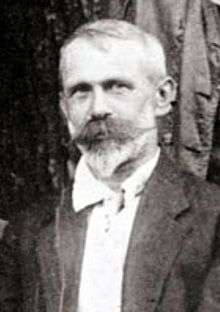Polish Autonomous District
Polish Autonomous Districts (called in Russian "полрайоны", polrajony, an abbreviation for "польские районы", "Polish raions") were national raions in the interbellum period possessing some form of a national autonomy in the Ukrainian and Byelorussian Soviet Socialist Republics of the USSR. They were created in an attempt to live up to the postulate of Leninism about the rights of nations for self-determination. Also, creation of these regions served one of purposes of the Bolsheviks - to export the revolution, since after their defeat in the Polish-Soviet War, the Soviets did not give up their idea of creating a Soviet Republic in Poland. Polish Autonomous Districts were supposed to be the origin of future Soviet Poland,[1] however, they both were disbanded in mid-1930s, and their populations expelled to Kazakhstan, with many of them killed during the Great Purge.
Origins

The possibility of granting autonomy to Polish-populated areas of the Soviet Union was discussed during the Polish-Soviet war by key persons involved in the Provisional Polish Revolutionary Committee. However, there were no plans to create whole districts; autonomy would be granted to separate villages. In 1925 it was decided that a district would be created in Soviet Ukraine, where, according to the 1926 survey, 476,435 Poles lived. This was 1.6% of the Ukrainian population, but in the Zhitomir Oblast, their number reached 10%. Among persons who supported the district were Soviet communists of Polish origin, such as Feliks Kon, Julian Marchlewski, Feliks Dzierżyński and Tomasz Dąbal. Thus Marchlewszczyzna was created, and later Dzierżyńszczyzna.
Marchlewszczyzna
Marchlewszczyzna was the Polish Autonomous District in Ukraine created on 22 March 1925, in eastern Volynia, 100 km west of Zhytomyr, with its capital at the town of Marchlewsk (known before and after as Dołbysz or Dowbysz, presently Довбиш - Dovbysh in Ukraine), located some 120 kilometers from the eastern border of the Second Polish Republic. It was named after the Polish Bolshevik Julian Marchlewski, who dreamed of Poland becoming part of the Soviet Union.
In the initial years of the district's existence, local Poles enjoyed limited autonomy, with 55 Polish-language schools, 80 reading rooms and a Polish daily Marchlewszczyzna Radziecka (Soviet Marchlewszczyzna). At the same time, its inhabitants were subject to intense communist propaganda. Polish grammar rules, regarded as bourgeoisie, were changed; however, the district lacked educated people. The majority of its inhabitants were Catholic peasants who were not interested in communist ideas. Therefore, such persons as Tomasz Dąbal were brought there to propagate atheism. An organization named the Polish Anti-Catholic Section was also founded.
Soviet authorities, who wanted to create Polish laborers, future citizens of the Polish Soviet Republic, built several factories as well as power plants and telephone lines. This also brought about improvement in the quality of life, but all efforts were destroyed in the early 1930s, when collectivization began. Polish peasants opposed it fiercely, and thousands of them perished in the Holodomor.
Initially, ethnic Poles constituted around 70% of district's population, which in 1926 totalled around 41,000. Other inhabitants were Ukrainians (20%), Germans (7%) and Jews. In 1930, after several adjacent villages were added to Marchlewszczyzna, the population grew to 52,000, with Poles still constituting 70%. It has been estimated that the district consisted of around 100 villages, settlements and smaller towns.
Dzierżyńszczyzna
Dzierżyńszczyzna was a Polish Autonomous District in Belarus, near Minsk and close to the Soviet-Polish border of the time. It was created on March 15, 1932, with its capital at Dzierżyńsk (Dzyarzhynsk, Dzerzhynsk, formerly known as Kojdanava Polish: Kojdanów). It was named after the bolshevik Felix Dzerzhinsky.
Similarly to Marchlewszczyzna, limited Polish autonomy in the area was a real fact, with Polish-language schools, libraries and institutions. At the same time, the inhabitants were subject to intensive communist propaganda. Religious life was suppressed, and the campaign of collectivization, carried out in mid-1930s, met resistance of local Polish peasants. Unlike Marchlewszczyzna, which was the real center of Polish cultural life in the Soviet Union, Dzierżyńszczyzna's influence was limited.
Disbanding
Polish districts were among those which resisted Soviet collectivization and atheization. For political reasons, drastic measures were initially not applied in these areas. Eventually, Marchlewszczyzna was disbanded in 1935 at the onset of the Great Purge and most of the administration was executed. In the following years, many men were shot (111,091 according to NKVD 00485 Order, women and children deported to Kazakhstan and other remote areas of the Soviet Union.[1] More than 50,000 Poles were executed in places like Kurapaty or Vinnitsa, many others were executed or starved in Kazakhstan. Dzierżyńszczyzna existed three years longer; it was disbanded in 1938. According to Polish sources, up to 70,000 Poles from Soviet Ukraine were forcibly resettled in Kazakhstan in late 1930s. Also, around 20 000 Poles were then deported from Soviet Belarus.
All Polish schools and libraries were closed, Tomasz Dąbal was executed in 1938.
After World War II, in both Polish and Soviet historiographies, the existence of the districts was omitted, perhaps because the authorities of both countries wanted to avoid uneasy questions about sudden rejection of the Leninist postulate of the rights of nations for self-determination.
The area of Marchlewszczyzna is still inhabited by the Polish minority, in the town of Dovbysh they make half of the population. There are also Poles in Dzierżyńszczyzna.
Sources
- Mikolaj Iwanow, Pierwszy naród ukarany. Polacy w Związku Radzieckim 1921-1939 (The first nation to be punished: Poles in the USSR, 1921-1939), Warsaw-Wroclaw. Panstwowe Wydawnictwo Naukowe. 1991. ISBN 83-01-10537-2
- Nikołaj Iwanow, Zapomniane ludobójstwo. Polacy w państwie Stalina. „Operacja polska” 1937–1938, Znak Horyzont, Kraków 2014
